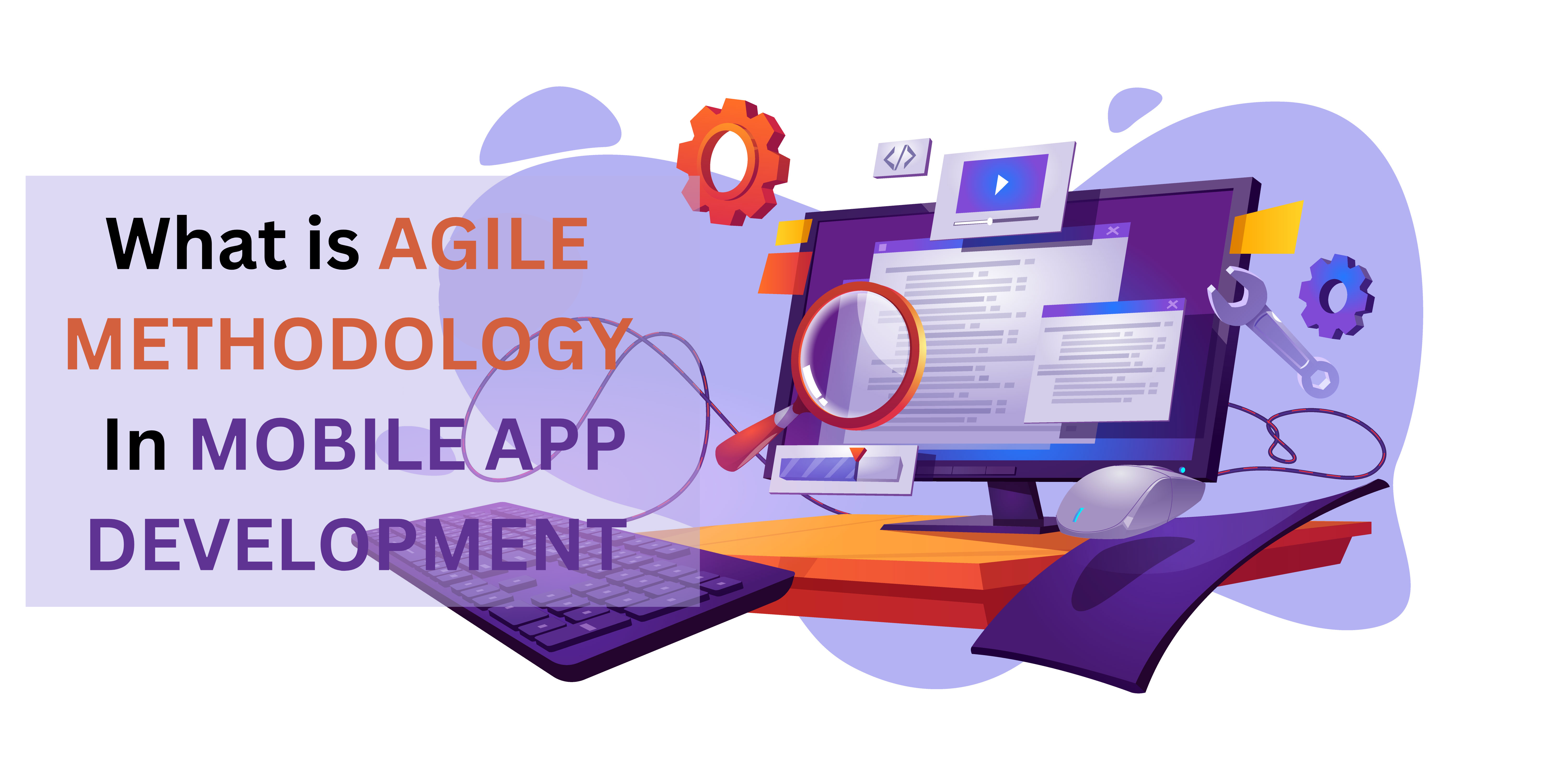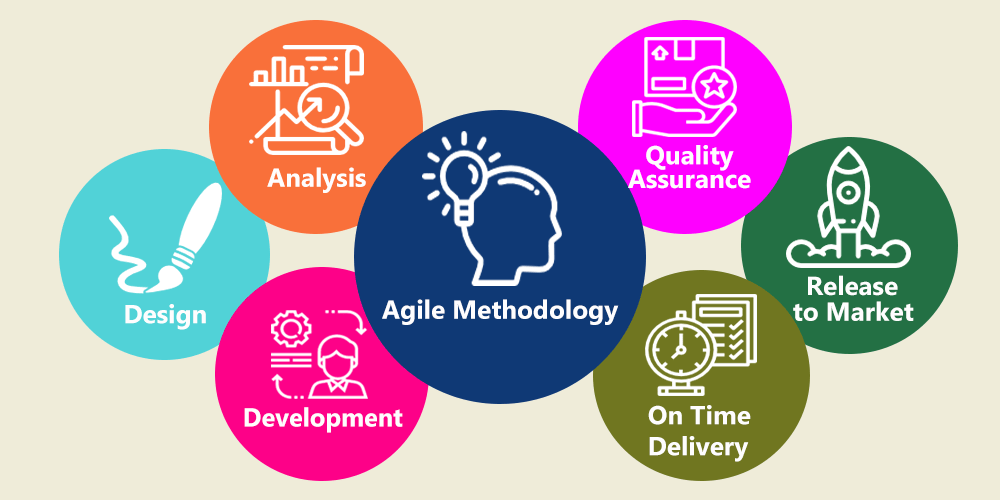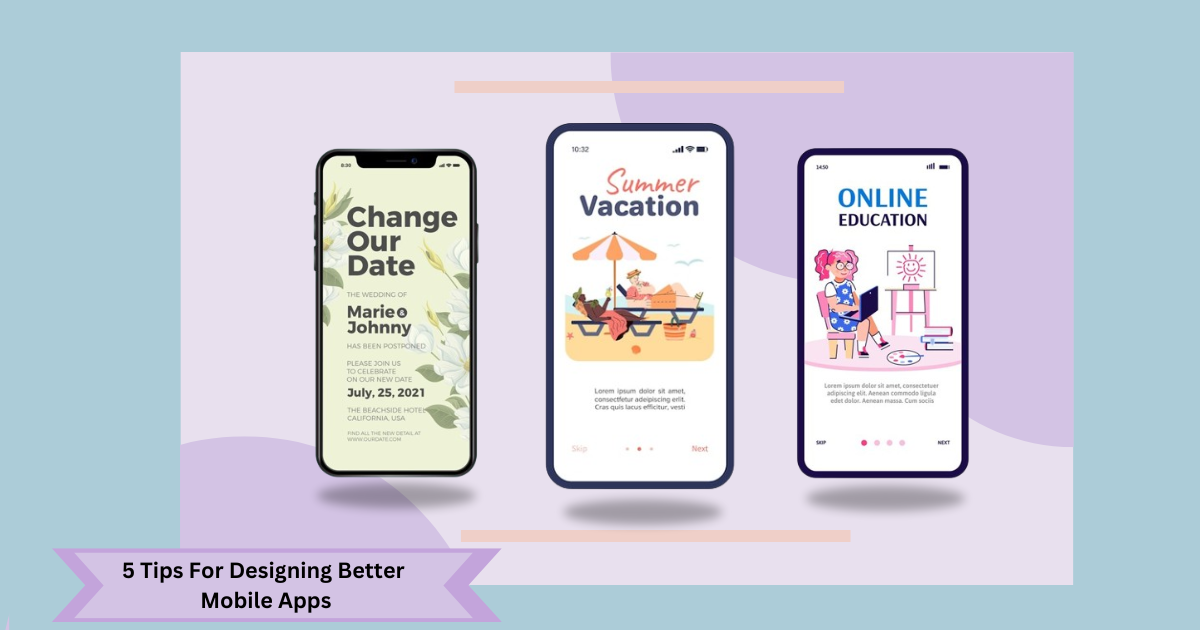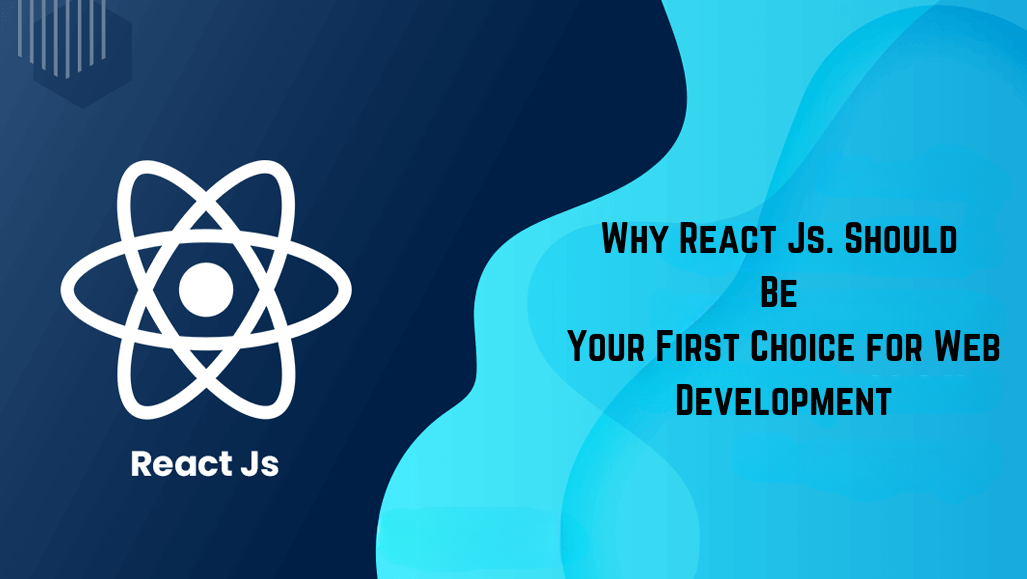“Turning your Mobile app concept into a reality requires the right approach and methodology.”
The concept of agile mobile app development focuses on an iterative and collaborative approach to software development. It emphasizes adaptability, flexibility, and providing instant value to the customer. Agile development methods prioritize customer satisfaction, team collaboration, and the ability to respond to changing requirements during the development process.
Rather than following a rigid and linear development approach, agile development promotes breaking down the development process into small, manageable increments known as iterations or sprints. Each iteration is focused on delivering a working and potentially shippable product enhancement, allowing for continuous feedback and refinement.
Developing a successful Mobile or web app can be a complex task with many challenges. These challenges can include rapidly changing user expectations, evolving technologies, market competition, and tight project deadlines. Additionally, understanding and defining app requirements, ensuring user satisfaction, and managing resources effectively are common constraints.
Traditional development approaches, such as the waterfall model, pose risks when it comes to turning app concepts into reality. The waterfall model follows a sequential process, where each step is completed before moving on to the next. However, this rigid structure can lead to challenges in adapting to changing requirements or incorporating user feedback. This can result in delivery delays, higher costs, and difficulty meeting the growing user needs and market demands.
Challenges and Risks Associated with Traditional App Development.
The challenges and risks associated with traditional development approaches underscore the need for a more flexible and adaptive methodology such as Agile. Agile development provides a solution by allowing iterative and incremental development, continuous feedback loops, and continuous improvement. Agile enables teams to respond rapidly to changes, address problems as they arise, and incorporate user feedback during the development process. This flexibility and adaptability are keys to successfully turning app concepts into reality.
By recognizing the challenges inherent in Agile Mobile App Development and understanding the limitations of traditional approaches, it becomes clear that Agile Mobile App Development provides a more effective solution. Agile’s emphasis on flexibility, collaboration and responsiveness to change enables development teams to overcome challenges and transform Web app Development concepts into successful products that meet user expectations and deliver value.
Understanding Core Principles of Agile Development:
The core principles of Agile development, as outlined in the Agile Manifesto, include:
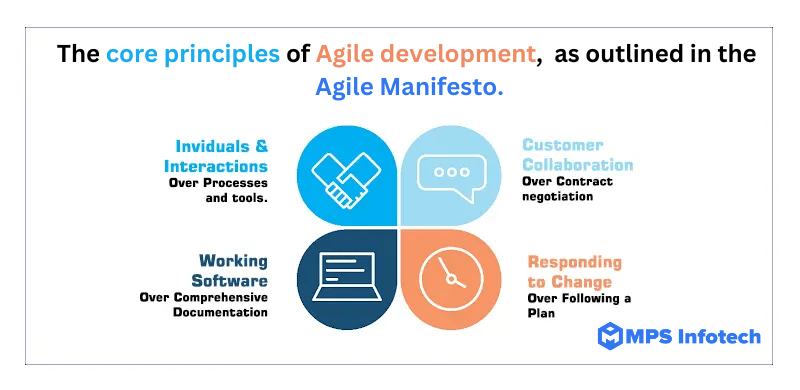
- Individuals and interactions over processes and tools: Agile values the importance of effective communication, collaboration, and teamwork among development team members and stakeholders.
- Working software over comprehensive documentation: Agile emphasizes the production of tangible and functional software as a measure of progress, while still acknowledging the need for documentation.
- Customer collaboration over contract negotiation: Agile encourages close collaboration and engagement with customers or end-users throughout the development process to ensure that the product meets their needs and expectations.
- Responding to change over following a plan: Agile recognizes that requirements and priorities can change, and it encourages teams to be adaptable and responsive to these changes, enabling quicker adjustments and improvements.
Agile development methodologies, such as Scrum and Kanban, provide frameworks and practices for effectively implementing Agile principles. These methodologies include iterative planning, frequent team interactions, regular feedback loops, and continuous improvements to optimize the development process and deliver valuable software enhancements in a short time frame.
Overall, the concept of agile development revolves around fostering collaboration, embracing change, and delivering high-quality software products through iterative development and a customer-centered approach.
How Agile addresses the challenges faced in Mobile App Development?
Agile development addresses the challenges faced in Hybrid Hybrid Mobile App Development through its iterative and incremental nature. Here’s an explanation of how Agile tackles these challenges:
Agile development promotes an iterative and incremental approach to building apps. Rather than attempting to define and deliver the entire Web app Development in advance, Agile divides the Mobile and Web app development process into smaller, manageable iterations called sprints. Each Sprint is focused on delivering a working and potentially shippable product increment.
By working in iterations, Agile allows for continuous feedback and collaboration. This iterative nature enables development teams to address challenges and incorporate changes or improvements throughout the development process. Regular feedback from stakeholders, customers, or end-users is sought and used to refine the app’s features, functionality, and design.
This iterative feedback loop ensures that the application closely aligns with user needs and expectations. This helps identify potential issues early, allowing for timely adjustments and course corrections. This flexibility enables teams to adapt to changing needs, market dynamics, and changing user expectations.
Furthermore, Agile development adopts an incremental delivery approach. Rather than waiting until the end of the development cycle to release the entire app, Agile encourages providing valuable and useful enhancements to the app at the end of each sprint. This incremental delivery provides opportunities for initial testing, user validation, and gathering valuable insights for further iterations.
The iterative and incremental nature of Agile development minimizes the risks associated with the traditional approach. This enables teams to quickly address challenges, incorporate continuous feedback, and iteratively refine the app. By doing so, Agile ensures that the final product meets the evolving needs of users and the market, resulting in a more successful Hybrid Mobile App Development journey.
The Agile Development Process:
The Agile development process consists of several key components that facilitate iterative and collaborative development. Here’s an explanation of the core components of Agile:
- User Stories: User stories are short and simple descriptions of desired features or functionalities from the point of view of end-users or stakeholders. They capture the “who,” “what,” and “why” of a specific user need or requirement. User stories serve as the building blocks of Agile development, guiding the team’s focus and prioritization throughout the project.
- Sprints: Sprints in Agile development are time-based iterations, typically lasting 1–4 weeks. Each sprint has a specific goal, and the development team commits to completing a set of user stories or tasks during that period. The sprint provides a structured time frame for delivering working increments of the app and allows for continuous evaluation and optimization.
- Iterations: Iterations refer to repeating cycles within a sprint. During an iteration, the team performs tasks such as planning, design, development, testing, and review. Iterations facilitate continuous progress and feedback, enabling the team to make improvements and adjustments based on the results of each iteration.
- Daily Stand-up Meetings: Daily stand-up meetings, also known as daily scrums, are short, focused meetings where team members discuss their progress, challenges, and plans for the day. These meetings encourage communication, collaboration, and transparency among team members. This ensures everyone is cohesive, identifies any roadblocks, and helps keep the development process on track.
- Backlog: A backlog is a prioritized list of user stories or tasks that need to be addressed during the development process. It serves as a dynamic repository of requirements and serves as a guide for the team’s work. The backlog evolves throughout the project as new requirements emerge or priorities change.
- Product Increment and Review: At the end of each sprint, the team delivers a working and potentially shippable product increment. This enhancement represents a solid portion of the app with additional features or improvements. It is then reviewed by stakeholders, end-users, or product owners to gather feedback and validate the direction of development.
These key components of Agile development create a structured framework for iterative development, continuous feedback, and incremental delivery. They promote collaboration, adaptability, and transparency, ensuring that the app evolves based on user needs and market dynamics throughout the development process.
How do Continuous Feedback and Collaboration work as leverage for Mobile App Development?
Continuous feedback and collaboration are essential components of Agile development, playing a crucial role in ensuring the success of Hybrid Mobile App Development and Web App Development Projects. Here are the key reasons why continuous feedback and collaboration are important:
- Alignment with User Needs: Continuous feedback allows for a close and ongoing relationship with end-users or stakeholders. By regularly seeking feedback on the evolving app features, functionalities, and website design and development units can ensure that the app aligns closely with user needs and expectations. This feedback-driven approach increases the chances of creating a successful and user-centric app.
- Early Issue Identification and Resolution: Through continuous feedback, issues, and potential problems can be identified early in the development process. By involving stakeholders and end-users in the feedback loop, teams can gather insights, uncover usability issues, discover bugs, and address concerns promptly. Early issue identification enables timely resolution, preventing the accumulation of major problems and reducing rework in later stages.
- Adaptation to Changing Requirements: Collaboration and continuous feedback facilitate agility in responding to changing requirements. As app development progresses, new insights and market dynamics may lead to evolving needs and priorities. By embracing continuous feedback and collaboration, development teams can adapt and adjust the app’s direction, features, and functionalities to meet these changing requirements effectively.
- Team Cohesion and Transparency: Continuous collaboration fosters a sense of teamwork and shared ownership among the development team. Regular interactions, such as daily stand-up meetings, encourage communication, transparency, and knowledge sharing. It helps align team members, ensures everyone is working towards a common goal, and facilitates a cohesive and productive working environment.
- Stakeholder Engagement and Satisfaction: Through continuous feedback and collaboration, stakeholders feel engaged and involved in the development process. By actively seeking their input and involving them in decision-making, development teams can address concerns, manage expectations, and ultimately increase stakeholder satisfaction. Engaged stakeholders are more likely to support the project, provide valuable insights, and become advocates for the app’s success.
Overall, continuous feedback and collaboration are vital for building successful apps. They enable development teams to iterate, adapt, and refine the app based on real-world insights and user input. By embracing these practices, development teams can create apps that truly meet user needs, improve overall quality, and increase the chances of delivering a successful product.
How does Agile allow for frequent updates and iterations based on user feedback?
Agile mobile app development methodology allows for frequent updates and iterations based on user feedback, enabling a responsive and user-centric approach to Mobile and Web app development. Here’s an illustration of how Agile facilitates this process:
- Continuous Feedback Collection: Agile teams actively seek feedback from end-users, stakeholders, and other relevant parties throughout the development process. This feedback can be obtained through user testing, usability studies, surveys, or direct interactions with users. By continuously collecting feedback, teams gain valuable insights into user preferences, pain points, and areas for improvement.
- Regular Review and Prioritization: Agile teams conduct regular reviews of the feedback collected. They analyze and prioritize the feedback based on its impact and alignment with project goals. By considering the feedback in prioritization discussions, the team can identify the most critical areas to address in upcoming iterations.
- Iterative Development: Agile development is organized into iterations or sprints, typically lasting 1-4 weeks. At the end of each iteration, the team delivers a working product increment. This increment includes the features and enhancements prioritized for that specific iteration. User feedback collected during the iteration informs the team’s decisions for subsequent iterations.
- User Story Refinement and Adaptation: Agile teams use the feedback to refine existing user stories or create new ones that reflect user needs and preferences. User stories capture specific functionalities or features from the user’s perspective. By adapting and refining user stories based on user feedback, the team ensures that subsequent iterations focus on delivering the most valuable and user-centric features.
- Continuous Improvement: Agile teams prioritize continuous improvement based on user feedback. They learn from user experiences, identify areas for enhancement, and make iterative adjustments in subsequent iterations. This iterative and feedback-driven approach ensures that the app evolves in line with user expectations and addresses any identified issues or usability concerns.
- Regular Retrospectives: Agile teams hold regular retrospectives at the end of each iteration to reflect on the development process. During retrospectives, the team discusses what went well, areas for improvement, and actionable steps to enhance the development process further. This feedback loop ensures that the team incorporates lessons learned and user feedback to continuously enhance the development process.
By leveraging frequent updates and iterations based on user feedback, Agile allows development teams to respond promptly to user needs, preferences, and changing requirements. This iterative and user-centric approach enhances the app’s quality, usability, and overall user satisfaction, resulting in a more successful and valuable end product.
Benefits of Embracing Agile Development:
1. Agile development enables faster time to market: By breaking down the development process into iterative sprints, Agile allows for the early delivery of working product increments. These increments can be released to users or stakeholders for feedback and validation. The iterative and incremental nature of Agile development enables faster time to market, as valuable features and functionalities are delivered in shorter cycles, reducing the overall development timeline.
2. Flexibility and adaptability of Agile in accommodating changing requirements: Agile methodologies, such as Scrum, embrace change and prioritize flexibility. Unlike traditional approaches, Agile allows for the incorporation of changing requirements throughout the development process. Development teams can adapt and adjust their priorities, features, and functionalities based on user feedback, market dynamics, or evolving business needs. This adaptability ensures that the app remains relevant and meets the evolving requirements of users and stakeholders.
3. Enhanced collaboration and communication within development teams: Agile methodologies promote collaboration and frequent communication among team members. Daily stand-up meetings, regular interactions, and collaborative tools facilitate transparency, shared understanding, and knowledge sharing. Agile fosters a collaborative environment where team members can work together, exchange ideas, address challenges, and collectively contribute to the success of the project. Improved collaboration leads to increased productivity, efficiency, and overall team satisfaction.
4. Promotion of a customer-centric approach and higher user satisfaction: Agile development puts a strong emphasis on customer collaboration and feedback. By involving users or stakeholders throughout the development process, Agile ensures that the app aligns with their needs and expectations. Continuous feedback loops and regular user involvement allow for early identification and resolution of issues, resulting in higher user satisfaction. Agile’s customer-centric approach ensures that the app delivers value and meets the intended purpose, enhancing overall user satisfaction and loyalty.
In summary, embracing Agile development offers several benefits. It enables faster time to market by delivering working product increments in shorter cycles. Agile’s flexibility and adaptability allow for accommodating changing requirements, ensuring the app remains relevant. Enhanced collaboration and communication within development teams foster a productive and cohesive working environment. Finally, Agile’s customer-centric approach ensures higher user satisfaction through continuous feedback and validation. Embracing Agile empowers development teams to create successful apps that meet user needs and deliver value efficiently and effectively.
Case Studies and Success Stories:
Following are some real-life examples of successful apps developed using Agile methodologies:
- Slack: Did you know that Slack, the popular team communication and support platform, was developed using Agile techniques? This approach allowed the development team to iteratively build and refine the app based on user feedback. The consistent components and features contributed to Slack’s success as a platform that’s both convenient and feature-rich for users. It’s no wonder why so many teams rely on Slack for their communication needs!
- Spotify: Many successful companies, including Spotify, have implemented Agile development practices to improve their products. Spotify used a feedback-driven and iterative approach to release regular updates and features that met the changing needs of its users and the music industry. This methodology has proven effective in creating products that not only meet but surpass user expectations.
How has Agile contributed to the transformation of app concepts into thriving products?
- Adaptability to Changing Requirements: Agile methodologies embrace change and enable teams to adapt to evolving requirements. By incorporating user feedback and market insights, Agile facilitates the transformation of app concepts into thriving products that remain relevant and aligned with user needs.
- Iterative and Feedback-Driven Development: Agile’s iterative approach allows for continuous improvement based on user feedback. This iterative and feedback-driven development cycle ensures that app concepts are refined and enhanced over time, resulting in products that are more robust, user-friendly, and successful in the market.
- Continuous Product Enhancement: Agile methodologies encourage regular releases of product increments, allowing organizations to gather real-time user feedback and insights. This feedback informs subsequent iterations and product enhancements, contributing to the continuous growth and transformation of app concepts into thriving products.
These examples and outcomes demonstrate how Agile development methodologies have been instrumental in the success of various apps. Agile’s iterative approach, emphasis on customer collaboration, and adaptability to changing requirements have played key roles in transforming app concepts into thriving and impactful products.
Getting Started with Agile Development: Practical Steps for Embracing Agile Development:
A. Define the Agile Implementation Strategy:
- Define the Agile Implementation Strategy:
- Educate and train the team: Provide training and workshops to familiarize team members with Agile principles, methodologies, and practices.
- Assess project suitability: Evaluate the project’s characteristics, complexity, and team dynamics to determine if Agile is the right fit.
- Select an Agile framework: Choose a suitable Agile framework such as Scrum, Kanban, or Lean, based on the project requirements and the team’s preferences.
B. Build Cross-Functional Teams and Establish Clear Goals:
- Form cross-functional teams: Create multidisciplinary teams comprising individuals with diverse skills and expertise required for the project.
- Encourage collaboration and communication: Foster an environment where team members collaborate, share knowledge, and communicate effectively.
- Define clear goals and objectives: Establish SMART (Specific, Measurable, Achievable, Relevant, Time-bound) goals to provide clarity and focus for the team.
C. Utilize Agile Tools and Techniques for Effective Implementation:
- Agile project management tools: Implement tools like Jira, Trello, or Asana to facilitate project planning, task tracking, and collaboration.
- Scrum ceremonies: Conduct regular Scrum ceremonies, including daily stand-up meetings, sprint planning, sprint reviews, and retrospectives, to promote transparency and team synchronization.
- User stories and backlog management: Utilize user stories to capture requirements from the user’s perspective. Maintain a backlog of prioritized user stories and regularly refine them.
- Iterative development and sprints: Divide the project into time-bound iterations or sprints, each delivering a working product increment. Ensure regular feedback and collaboration with stakeholders during and at the end of each sprint.
- Continuous integration and testing: Emphasize continuous integration and automated testing to ensure the stability and quality of the evolving product.
- Visual management and information radiators: Use physical or virtual boards to visualize project progress, tasks, and blockers. Information radiators help the team stay updated and focused.
D. Foster a Continuous Improvement Mindset:
- Conduct retrospectives: Regularly hold retrospectives to reflect on the team’s performance, identify areas for improvement, and take actionable steps to enhance the Agile implementation.
- Embrace feedback culture: Encourage open and honest feedback from team members and stakeholders to drive continuous improvement.
- Adapt and refine: Be open to adjusting and refining Agile practices based on the team’s experience, project requirements, and evolving needs.
By following these practical steps, organizations can successfully embrace Agile development. Building cross-functional teams, establishing clear goals, utilizing Agile tools and techniques, and fostering a continuous improvement mindset is essential for effective implementation and reaping the benefits of Agile methodologies.
Common Challenges and Roadblocks in Agile Development:
- Resistance to change: Some team members or stakeholders may resist adopting Agile methodologies, preferring traditional approaches.
- Lack of clarity in roles and responsibilities: Ambiguity in defining roles and responsibilities can lead to confusion and inefficiencies within the team.
- Unrealistic expectations: Setting unrealistic goals or expecting instant results can undermine the Agile process and lead to frustration.
- Poor communication and collaboration: Inadequate communication and collaboration among team members can hinder progress and create misunderstandings.
- Incomplete or evolving requirements: Unclear or changing requirements can impact the ability to deliver a stable and well-defined product increment.
Tips and best practices for overcoming these challenges:
- Address resistance to change: Communicate the benefits of Agile to team members and stakeholders, provide training and support during the transition, and gradually introduce Agile practices to build trust and confidence.
- Define roles and responsibilities: Clearly define roles, responsibilities, and expectations for each team member to promote accountability and collaboration.
- Set realistic expectations: Educate stakeholders on the Agile process and emphasize the iterative nature of development. Set achievable goals and manage expectations through regular communication and transparency.
- Foster communication and collaboration: Encourage open and frequent communication within the team, promote a collaborative culture, and use collaborative tools to facilitate communication and knowledge sharing.
- Prioritize requirements and maintain a flexible mindset: Continuously engage with stakeholders to refine and prioritize requirements. Embrace change and adapt to evolving needs while ensuring the stability of the product.
Strategies for maximizing the benefits of Agile in turning concepts into reality:
- Embrace user involvement: Actively involve users and stakeholders throughout the development process to gather feedback and ensure alignment with their needs.
- Implement an iterative and incremental approach: Break down the project into manageable iterations or sprints, delivering value in each cycle while incorporating feedback for continuous improvement.
- Foster a collaborative and empowered team: Encourage collaboration, empower team members to make decisions, and provide a supportive environment that enables creativity and innovation.
- Emphasize continuous improvement: Regularly reflect on the team’s performance, identify areas for improvement, and implement changes to enhance the Agile process.
- Maintain a customer-centric focus: Continuously validate and refine the product based on user feedback and market insights to ensure the final product meets customer expectations.
By addressing common challenges, implementing best practices, and leveraging effective strategies, organizations can maximize the benefits of Agile development in turning concepts into successful and impactful products.
Embracing Agile methodologies can be the key to transforming your app ideas into successful realities. By adopting Agile, you unlock the potential to deliver a high-quality app faster, adapt to changing requirements, collaborate effectively, and keep your users at the center of the development process. Agile empowers you to iterate, learn, and continuously improve, ensuring that your app meets the needs and expectations of your target audience. Don’t hesitate to embrace Agile and embark on your Mobile and Web app development journey with confidence.
Are you ready to turn your app concept into a reality? Start by taking the first step towards Agile development. Educate yourself on Agile methodologies, understand the principles, and explore the different frameworks such as Scrum or Kanban. Seek training or guidance to equip yourself and your team with the necessary skills and knowledge. Embrace the mindset of collaboration, flexibility, and continuous improvement. It’s time to bring your app ideas to life with Agile development. Take action today and witness the transformative power of Agile in turning your dreams into successful Mobile and Web app products.

